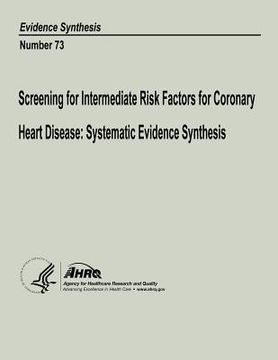Screening for Intermediate Risk Factors for Coronary Heart Disease: Systematic Evidence Synthesis: Evidence Synthesis Number 73 (en Inglés)
Reseña del libro "Screening for Intermediate Risk Factors for Coronary Heart Disease: Systematic Evidence Synthesis: Evidence Synthesis Number 73 (en Inglés)"
In the United States, coronary heart disease (CHD) and cardiovascular disease (CVD) account for nearly 40% of all deaths each year. Several risk factors for CHD and CVD, such as tobacco use, elevated low-density lipoprotein cholesterol (LDL-C), hypertension, hypercoagulable states, and obesity, are modifiable. Identifying individuals at risk, encouraging therapeutic lifestyle changes, and, when appropriate, initiating drug treatment to reduce LDL-C, are highly effective measures to reduce an individual's risk of coronary events and stroke. An individual's risk for CHD events (or sometimes CVD events) guides the intensity of LDL-C lowering and other interventions. For this reason, assessing an individual's risk plays an important role in initiating measures to modify risk. Several risk stratification systems are available for this purpose. We conducted a systematic review of epidemiologic studies of certain emerging risk factors to help the US Preventive Services Task Force (USPSTF) determine which, if any, factors should be incorporated into guidelines for coronary and cardiovascular risk assessment in primary care. The USPSTF selected all but one of the risk factors examined in this report. After a preliminary literature review, the authors of the report added one factor, periodontal disease. The population of interest for this review consists of asymptomatic adults who are identified as being "intermediate risk" after calculating the Framingham risk score. This target population excludes individuals with diabetes, coronary disease, peripheral vascular disease, and other individuals who have a predicted 10-year risk of "hard" coronary artery disease (CAD) events greater than 20%. Figure 1 shows that, after testing with one of the "emerging" risk factors, some intermediate-risk individuals are reclassified as "high-risk" (greater than 20% risk of hard CAD events over 10 years) or "low-risk" (less than 10% risk over 10 years.) As a result of reclassification to high-risk, these individuals would be managed with more aggressive risk factor modification which could result in an improved risk profile and in greater reductions in the incidence of CAD than they would be expected to have if they were managed as intermediate-risk patients. The USPSTF selected the following Key Questions for this report: 1. Compared with Framingham risk factors alone, does risk stratification of asymptomatic adults using novel risk markers lead to reduced incidence of cardiovascular events (myocardial infarction, angina, sudden death, cerebrovascular accident), coronary heart disease events, or overall mortality? 2. What novel risk markers accurately predict cardiovascular events independent of Framingham risk factors? What is the added predictive value of novel risk markers? a) What is the prevalence of these risk markers among intermediate-risk and low-risk individuals? b) At what frequency does application of these novel risk markers significantly change the 10-year risk of cardiovascular events based on traditional risk factors alone (e.g., from intermediate risk [10-20%] to high risk [greater than 20%] or to low risk [less than 10%])? 3. What are the harms of risk assessment? 4. a) In groups identified as high-risk (greater than 20% 10-year risk) by novel risk markers, does aggressive risk factor modification (treatment to lower blood pressure and lipid targets or more intense counseling) lead to improved intermediate outcomes (e.g., reduction in lipid levels; reduction in blood pressure; increased physical activity; healthy dietary changes, etc.)? b) Does improvement in intermediate outcomes lead to reduced incidence of cardiovascular events (myocardial infarction, angina, sudden death, cerebrovascular accident), cardiovascular disease-specific mortality, overall mortality? 5. What are the harms of aggressive risk factor modification? 6. What are the costs associated with risk factor assessment and aggressive risk factor modification?

